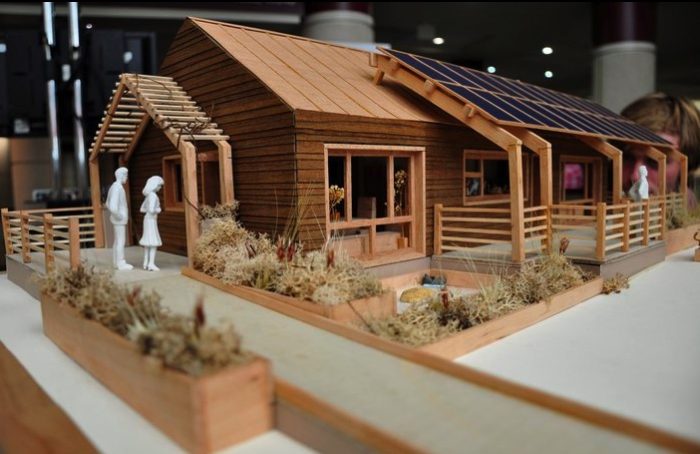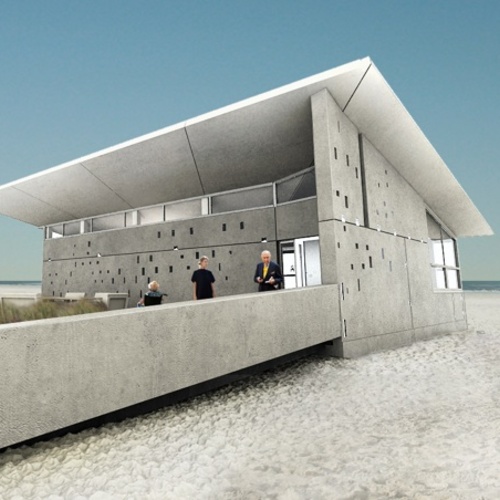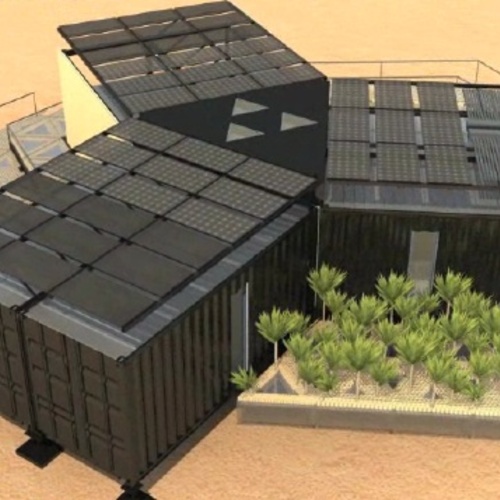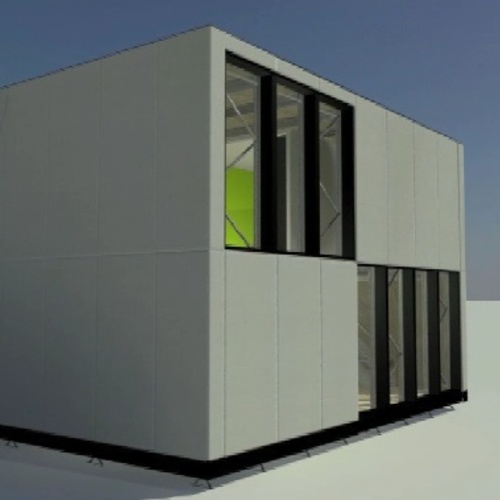
Image Credit: Team Massachusetts: Massachusetts College of Art and Design and the University of Massachusetts at Lowell
Image Credit: Team Massachusetts: Massachusetts College of Art and Design and the University of Massachusetts at Lowell 4D Home includes an overhang of photovoltaic panels that is offset from the south-facing roof to both shade it and increase ventilation for the array. The house also will be equipped with a solar hot water system. The kitchen separates the living area from the private areas, and anchors the central section of the house. The 4D Home living area is at the southeast corner of the building. The living area can be expanded by sliding the partition, shown gliding away from the far wall on the left, into the central section of the house. The guest room is in the northwest corner of the house. It is separated from the dining area, in the southwest corner of the building, by another moveable partition. The 4D Home dining space, looking southwest.
One of the key design variables in Team Massachusetts’ Solar Decathlon entry, 4D Home, is the configuration of its interior, which, with the repositioning of two sliding partitions, can be quickly altered to accommodate a variety of situations, from a dinner party attended by several guests to a permanent addition to the family. “The 4D Home is about a home that works in the fourth dimension, which is over time. Our target market is a family of three, preferably with a young child, and the idea is that this house can transform with the family over time and adapt to a family’s changing needs,” Evon Calabrese, an architectural designer from Massachusetts College of Art and Design, told Fine Homebuilding’s Justin Fink at the International Builders’ Show in January. With its gabled roof, 4D Home, at just under 1,000 sq. ft., takes a cue from New England’s traditional rural architecture, but its construction and performance goals are based on thoroughly contemporary precepts of energy efficiency and affordability.
Live at the International Builder’s Show
Project manager Spencer Culhane tells GBA that Team Massachusetts – a collaboration of students and faculty at Massachusetts College of Art and Design and the University of Massachusetts at Lowell – has designed 4D Home to perform to the Passivhaus standard. The stick-frame walls will be insulated to R-56.6 with 4 in. of closed-cell spray foam and 7 in. of blown-in fiberglass. The roof will be framed with 14-in. Nordic prefabricated I-joists and insulated to R-64.4 with 4 in. of spray foam and 10 in. of blown-in fiberglass. Zip System sheathing will be used on the exterior surfaces. The PV array as a source of shade and electric power Rather than mounting photovoltaic panels on the building’s standing-seam metal roof, the team has designed a trellis that raises the 6.7 kW (386 sq. ft.) Sunpower array above the south-facing roof surface, enhancing ventilation under the panels and shading the roof and (with the trellis assembly’s overhang) the front of the building during the warm months.
MORE INFORMATION Team Massachusetts Web page DOE Web page for Team Massachusetts Team Massachusetts Facebook page GBA Resource Guide for 2011 Solar Decathlon
Culhane points out that the team is using a SunDrum flat-plate solar thermal collector that attaches to the back of the array to both cool the panels and generate hot water. The house is also equipped with a dehumidifier and a heat pump for space heating and cooling. Aside from a Roto Frank skylight that will be mounted near the middle of the north side of the roof, Makrown 88 triple-glazed windows will be used throughout. A test build in Boston The team, about 60 people in all, is set to build its 4D Home this summer in Boston’s Marine Industrial Park, test it for further improvements, and then begin deconstructing the building for transport to the National Mall. Culhane says the thermal envelope will ship in four sections, with the decking, which will be flat-packed, shipped separately. Based on the team’s last cost estimate, the home is currently priced at $260,000. Culhane adds, however, that “we are making design refinements to bring that number down to $250K for the competition.” After the competition, the team plans to sell the home and, as noted in a recent Boston Globe article, is already talking to prospective buyers.
Weekly Newsletter
Get building science and energy efficiency advice, plus special offers, in your inbox.















0 Comments
Log in or create an account to post a comment.
Sign up Log in